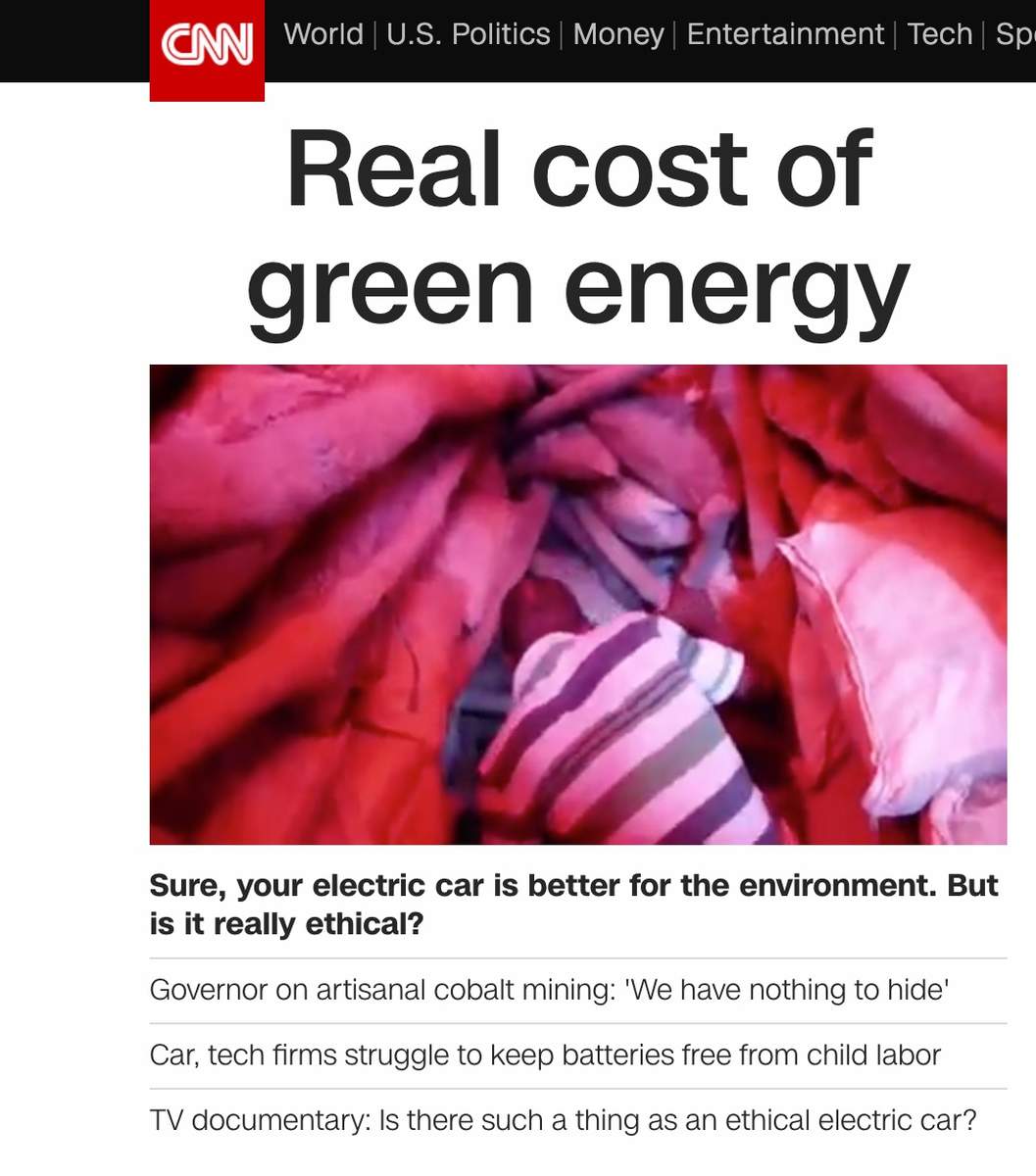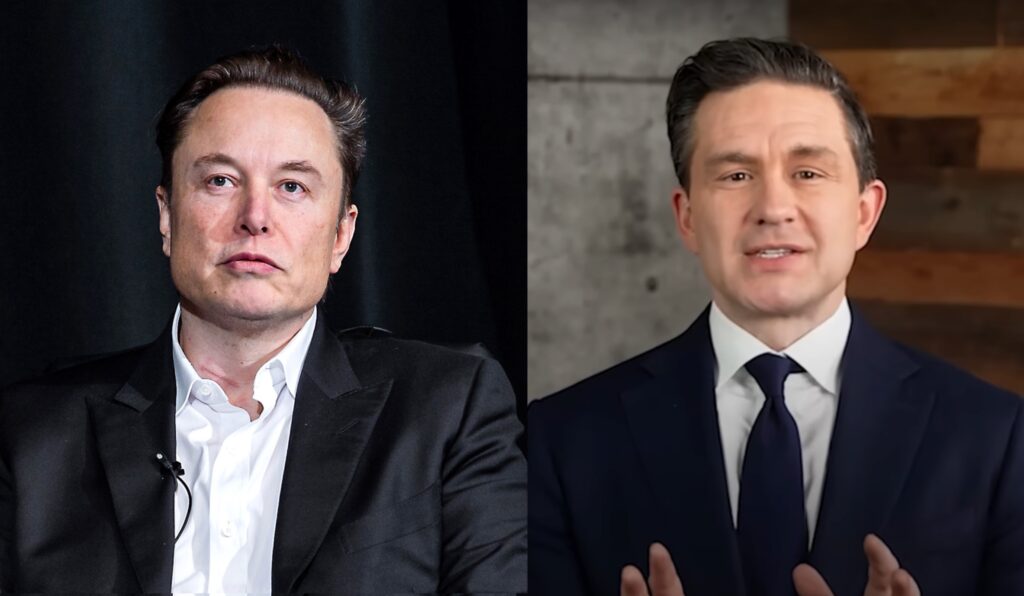This week, CNN published a startling multimedia report on cobalt mining in the Democratic Republic of Congo. The investigation revealed troubling conditions in so-called “artisanal” cobalt mines, where hand mining operations are carried out with a combination of unsafe working conditions and child labor. As is all too often the case with resource extraction — whether for cobalt in Congo, oil in Ecuador, or coal in West Virginia — unsafe, unhealthy local labor practices deserve media exposure.
Unfortunately, CNN’s promotion of the investigation and headline misappropriate the blame, leaving casual readers to conclude that electric vehicles are responsible for these awful labor conditions.
The headline that ran in the top spot on CNN.com’s international edition on Monday warned of the “Real cost of green energy” and asked, “Sure, your electric car is better for the environment. But is it really ethical?”
In reality, electric cars still represent a small percentage of the market for mined cobalt, and laptops, cell phones, airplanes, medical equipment, and military applications are large consumers of the raw material.
Cobalt Mining Gets the Attention it Deserves
The investigation by CNN echoes other similar exposés published over the past two years. In 2016, Amnesty International blew the doors open on the issue, revealing “the hazardous conditions in which artisanal miners, including thousands of children, mine cobalt in the Democratic Republic of the Congo.” The Amnesty International report goes on “to trace how this cobalt is used to power mobile phones, laptop computers, and other portable electronic devices.”
Later in 2016, the Washington Post ran a multimedia piece on the “cobalt pipeline,” with a headline that promised to “[trace] the path from deadly hand-dug mines in Congo to consumers’ phones and laptops.”
The Post returned to Congo this year, publishing a powerful and disturbing photo essay in February on “the hidden costs of cobalt mining.” And CBS News ran an investigation in March finding child labor still being used for cobalt mining in Congo.
Unfortunately, these reports have been used by fossil fuel proponents to attack electric vehicles, often directly attributing the growing market for EVs, many of which use lithium ion batteries or other battery technologies that rely on cobalt, with the troublesome labor practices associated with hand mining for cobalt. CNN’s report plays into this deceptive messaging.
Cobalt and Electric Vehicles, By the Numbers
According to the U.S. Geological Survey, 58 percent of the world’s cobalt is mined in Congo. (CNN’s investigation claims in consecutive slides, that “two-thirds of the world’s cobalt come from Congo” and that 58.8 percent is cobalt produced in Congo, providing the London Metal Exchange as the source for the latter figure). Of the cobalt sourced in Congo, according to CNN, roughly one-fifth is mined by hand. Accordingly, roughly 7.5 percent of the world’s cobalt is mined in the disturbing manner portrayed in the CNN multimedia piece.
That’s still far too much, of course, but the startling conditions at the “artisanal” hand mines shown by CNN are still the minority fringe of the industry.
Additionally, electric vehicles — which CNN’s headline and language within the article blames for the unethical mining practices — are responsible for a relatively small percentage of the total cobalt that is mined, marketed, and put to use.
Rechargeable batteries (like lithium ion) make up about 42 percent of the market for cobalt, according to the Cobalt Development Institute.
Of the 42 percent that is used for batteries, roughly one-quarter is used for electric vehicles.
In other words, just over 10 percent of the world’s cobalt supply is currently being used for batteries to power electric cars.
The bigger culprits are portable consumer electronics — like cell phones and laptop computers — which use around 72 percent of the cobalt that goes into lithium ion batteries, or roughly 30 percent of all cobalt mined.
Another 16 percent of cobalt demand is for the production of superalloys, typically used for for casting airfoils and other structural parts of turbine engines for jets and natural gas power plants.
The production of carbides and diamond drills for industrial operations currently uses the same amount of cobalt, 10 percent, as electric vehicles do.
Other major uses are for manufacturing steel, magnets, and medical equipment.
Alternatives to Unethical Cobalt: Sourcing, Substitution, and Recycling
As the market for electric cars grows, battery- and automakers will have to reckon with their supply chains for cobalt and to find alternatives. Fortunately, there are better places to get cobalt than the artisanal mines in Congo, and alternative chemistries and cobalt recycling are also providing promising pathways toward lowering raw cobalt demand.
According to the Amnesty International report that first opened the world’s eyes to the troubles of cobalt mining in Congo, Tesla was not called out “because its main battery cell supplier, Panasonic, sources its cobalt from the Philippines and not Congo.” Tesla also has committed to sourcing cobalt and other raw materials exclusively from North America for its new Gigafactory battery production facility.
Car companies should do more to provide transparency in their supply chains to ensure that they are not supporting the market for unregulated, dangerous hand-mining operations in Congo. Many are taking steps in the right direction, and companies like Apple could provide a valuable example for how to avoid “unethical” or “conflict” cobalt.
Additionally, alternative battery chemistries are already proving to reduce the need for cobalt. As Reuters reported last year, Asian battery makers have “tweake[ed] the recipe,” and are cutting in half the amount of cobalt needed per battery.
Tesla has started using nickel-cobalt-aluminium-based (NCA) battery cells made by Panasonic, which the companies claim use far less cobalt than other, traditional forms of lithium-ion batteries.
Other electric car companies, like China’s BYD, are using cheaper lithium-iron-phosphate batteries that don’t use cobalt at all.
Finally, the cobalt recycling industry is breaking out. With cobalt prices at record highs, companies are developing new recycling processes that can recover 100 percent of the raw material. Already, 15 percent of cobalt used in the United States is sourced from recycled scrap. As those processes are refined, and the costs of raw cobalt continue to spike, recycled cobalt likely will become increasingly economical and an integral part of any responsible battery producer’s supply chain.
There is no question that the worst corners of the cobalt industry are rife with human rights and labor issues. But, as Josh Goldman of the Union of Concerned Scientists writes, “let’s also not forget that the supply chain for gasoline-powered vehicles has its fair share of issues, ranging from human rights violations like the use of child labor, to disastrous oil spills like Deepwater Horizon.”
Electric cars are still a small, but growing, part of the market for raw cobalt. Electric carmakers, however, will continue to improve battery technology to reduce dependence on cobalt and can better source the cobalt that they do require from well-regulated mines and from recycled resources. Meanwhile, gasoline-powered cars will always depend on oil, which has a long and irrefutably exploitative supply chain that harms communities at the point of extraction, in the areas that is it refined, and then again when the byproducts of its combustion spew out of tailpipes.
Main image: The foreman for a mining company holds up a fragment of cobalt in Mpaza, Rwanda. Credit: Alan Whelan/Trócaire, CC BY 2.0
Subscribe to our newsletter
Stay up to date with DeSmog news and alerts








